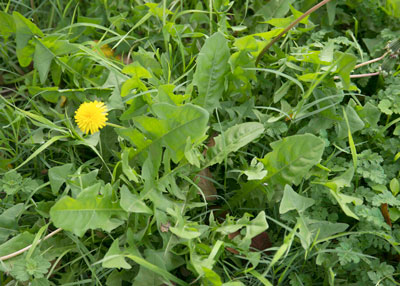Question of the Week: February 4, 2016
“How can I eliminate all the weeds I have in my lawn now?”

Annual bluegrass (Poa annua) in a dormant Texas lawn in winter
Weeds that are growing in your lawn at this time of year are classified as “cool-season” weeds. That means that they germinate in the early fall, grow during the fall, winter and early spring and then burst into flower and seeds.
Grassy weeds, including annual bluegrass (Poa annua), rescuegrass and annual ryegrass can be prevented by application of pre-emergent weedkiller granules (Team, Dimension or Halts) in the last week of August or the first week of September. Soon after that, the seeds will have germinated and pre-emergents will have no effect. In fact, there is no way to eliminate existing grassy weeds in turf without killing the desirable grass, so the pre-emergent application is your only option. At this point, all you can do is wait it all out. They will soon disappear into the greening turfgrass come spring.

Dandelions and other broadleafed weeds in winter lawn
Broadleafed weeds, including henbit, chickweed, dandelions and clover, can also be prevented with the pre-emergent herbicide Gallery applied in that same late August/first week of September period. But with these weeds, you do get a second chance. You can apply a broadleafed weedkiller spray (containing 2,4-D) to eliminate the weeds without harming your turf. Read and follow the label’s directions for best results.
And a word about “weed-and-feed” products:
The word that I have chosen is “avoid.” The reason that I give is that there is seldom a time when (a) you can get good control of weeds with the herbicide and (b) need to feed at the same time. You’ll either be too early for the fertilizer or too late for the weedkiller. You also run great risk of damaging your trees and shrubs that share the same soil.

